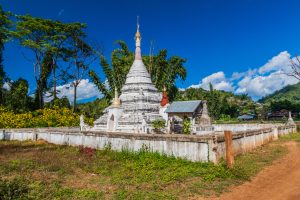As the military junta in Myanmar continues to face mounting losses on the ground, the dominant narrative has shifted from “the military is too big to fail” to fears of Myanmar becoming a “failed” or “fractured” state. Recently, many analysts, mostly from outside Myanmar, have painted a grim picture of the country’s post-conflict future. They argue that, without the military in power, Myanmar risks collapsing into a failed state or, at best, becoming deeply fragmented. These views often cite examples like Libya, Liberia, Sierra Leone, and Egypt as evidence that Myanmar is unlikely to transition into a cohesive democratic state after the fall of its military regime.
For those unfamiliar with the realities on the ground, such arguments may appear credible. However, while lessons from other countries can provide valuable insights, they do not necessarily determine Myanmar’s future. The people of Myanmar and its resistance forces have already defied many of these dire predictions. Initially armed with only basic weapons against a heavily militarized regime, these resistance forces have been able to free 67 percent of the population from the junta’s control in less than four years, according to a recent report by the Special Advisory Council on Myanmar. The military is now primarily dependent on airstrikes and is increasingly targeting civilians in an attempt to spread fear and weaken support for the resistance.
Yet, nearly four years after the 2021 coup, and despite the regime’s ongoing brutality, the vast majority of the Myanmar population continues to reject military rule and remains more determined than ever to remove the junta. This success is a testament to the unprecedented collaboration among all resistance forces, which marks a profound shift in Myanmar’s political landscape. The junta’s long-standing strategy of exploiting ethnic and religious divisions is being actively dismantled by a common resistance front. This diverse coalition, forged through shared struggle, is paving the way for a more inclusive, federal, and democratic Myanmar. The resilience of the resistance demonstrates the people’s determination to overcome old divisions and build a democratic future.
While political science models provide useful frameworks, they often miss the deeper psychological and social dynamics at play. Comparisons to countries like Libya, Liberia, Sierra Leone, and Egypt fail to account for key differences, which suggest Myanmar could follow a more positive path.
Myanmar vs. Libya:
Unlike Libya, where post-conflict recovery involved building national institutions from scratch in a fragmented environment, Myanmar has a history of semi-democratic governance and established political parties, not least the National League for Democracy. Myanmar also has experience with ethnic armed organizations (EAOs) that have participated in ceasefires and peace negotiations. These factors provide a foundation for reforming and democratizing existing institutions rather than starting from scratch, as was the case in Libya.
Myanmar vs. Liberia:
Liberia’s civil war was driven by ethnic grievances, elite dominance, and battles over resources, with significant external involvement. In contrast, Myanmar’s conflict is primarily about ethnic self-determination and opposition to military rule, with a focus on political autonomy, human rights, and federal governance. Furthermore, the international response to Myanmar has been more focused on sanctions and humanitarian concerns, without the kind of regional military intervention seen in Liberia.
Myanmar vs. Egypt:
In Egypt, while civil society played a role in the 2011 revolution, it has been severely repressed under President Sisi’s rule since the 2013 coup. In contrast, Myanmar’s civil society has remained strong and active, especially since the military takeover in 2021. The National Unity Government (NUG), made up of ousted lawmakers, activists, and ethnic leaders, has emerged as a key opposition force. Unlike in Egypt, Myanmar’s civil society is likely to play a significant role in shaping governance, advocating for human rights and promoting ethnic reconciliation in the post-conflict era.
Myanmar vs. Sierra Leone:
Sierra Leone’s civil society was relatively weak during and after its civil war, relying heavily on external actors for peacebuilding and recovery. In Myanmar, however, civil society – especially since the 2021 coup – has been far more robust. Pro-democracy movements, activist groups, and ethnic organizations have been central in resisting military rule. In a post-conflict transition, Myanmar’s civil society is likely to be a key player, unlike in Sierra Leone, where external forces played a larger role in the peace process.
It is inappropriate to use these examples to predict Myanmar’s future after the fall of the military junta. Key differences in Myanmar’s historical context, civil society, and resistance movements point to a more optimistic trajectory. Unlike the cases mentioned above, Myanmar’s public demand for accountability is widespread, applying to everyone, including the People’s Defense Forces, civil society organizations, and the NUG. There is also growing pressure on the resistance coalition to address episodic violence in regions like Sagaing and Tanintharyi.
The 10 years of relative openness, with rapid economic and educational growth, laid the foundation for this revolution. Moreover, Myanmar’s state institutions, many of which have roots in the British colonial era, have proven resilient. Long-standing EAOs also possess administrative capacities that provide a foundation for local or state-level governance, rather than chaos.
Political equality has been a topic of discussion in Myanmar for over 70 years, but today it is a much more widespread conversation across the country. The military junta itself is responsible for the current crisis, having initiated unnecessary and violent actions that triggered the resistance. This is fundamentally different from the Arab Spring countries, where uprisings were more spontaneous.
While the challenges facing Myanmar and its people are immense, there are strong reasons to believe that the country has the potential to emerge as a new, federal, and democratic nation.
































